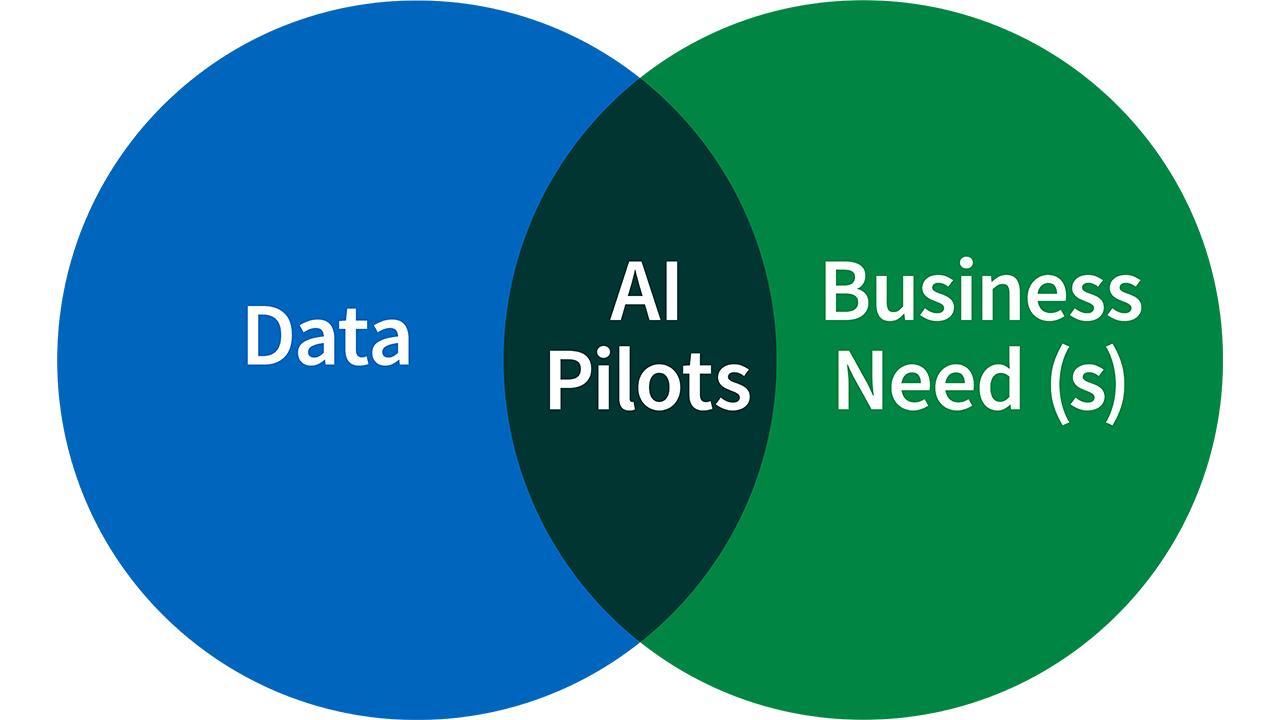
In large part, organizations apply AI to specific business needs but struggle to adopt AI at the enterprise level. This may lead to redundant AI solutions and lack of standardization in addressing similar business needs. At Tetra Tech, we help clients effectively apply AI throughout their organizations using the process outlined below.
Step 1: Identify your organization’s needs
The first step in this framework is to select a business need(s) that requires a lot of human intervention. Business problems that require a lot of human inference, cognitive-heavy processes, or complex decision-making are good candidates. In addition to the business problem(s), you will need to collect available data—including images and structured or unstructured data—that adequately represents the problem space.

When examining potential problems, it is crucial your project focuses on a challenge your organization cares about to ensure you’ll have impactful results. Organizational buy-in is needed to scale from an AI pilot to a production ready system.
Many business problems can be resolved using algorithms that leverage both natural language processing (NLP) and computer vision. These widely adopted algorithms are mature enough for enterprise applications.
Business needs that can be addressed with NLP include:
- Answering questions and fulfilling requests—Look for repeated conversations in your business workflow, which are potential areas to augment with a chatbot
- Analyzing documents—NLP can analyze documents to determine relevant topics and make the content easy to search based on context
- Updating records—Voice and written inputs from customers can be updated automatically in the customer relationship management (CRM) system
Business needs that can be addressed via computer vision include:
- Automating data entry—This enables you to make archived data or new data searchable and decrease backlogs
- Processing geospatial imagery—Because it takes significant time for humans to review each image, computer vision is effective in scaling the analysis
- Analyzing video surveillance—Algorithms can perform the initial screening and flag unusual objects, enabling reviewers to focus on high-value work and final determinations
Step 2: Start with small and meaningful outcomes
After you identify the business needs that you want to address, you need to create a pilot project scope that is well-defined, small in scale, and technically feasible. By limiting the scope of a project and ensuring technical feasibility, you can make it easier to measure success and demonstrate impact quickly. The purpose of the pilot is to demonstrate what’s possible, increasing AI awareness and adoption in your organization. As stakeholders in your organization see AI capabilities in action through demonstrations, pilots, and prototypes, your organization will better understand AI and its benefits. While it is tempting to aim for a large-scale solution immediately, a smaller and more meaningful project lowers potential risks while providing greater impact.
Step 3: Use high-quality data in large quantities
Building a pilot that leverages AI requires high-quality data in large quantities. High-quality data is well-formatted and adequately represents a problem space. To train the model, you can use real data or synthetic data that represents the same structure and format as live data. Useful metadata and clear documentation also will help in the pilot implementation. Without these crucial elements, it will be difficult to develop an AI solution that produces accurate results. The data’s infrastructure also plays a role, enabling the pilot to retrieve the current data in a simple manner and access new data as it comes in. Prior investments in cloud infrastructure and data governance aid the efficiency of data retrieval and accelerate the pilot implementation. Organizations can also consider third-party data to augment proprietary data sets.
Step 4: Explore different algorithms and techniques
AI algorithms differ from traditional software because developers spend more time evaluating the model rather than writing explicit instructions. For each pilot, the team must identify the inputs and outputs. Algorithms are selected based on the type of problems you are solving. The team likely will explore many different algorithms. An ensemble of different methods often performs the best. Data scientists must focus on manually curating, maintaining, massaging, cleaning, and labeling data sets. The data is then used to optimize the model.
You can refer to decision charts and cheat sheets that help you choose the right algorithm for a predictive analytics model. While not exhaustive, references such as those published by the open source Scikit-learn machine learning library and Microsoft Azure are useful when the team is starting exploration. We recommend considering open source technologies for the cost and maturity. Most of the widely adopted AI programming libraries are supported by large tech companies. Using open source solutions can decrease the risk of vendor lock-in, support finding and retaining top talent, and reduce licensing and maintenance costs.
Step 5: Improve the models and curate the training data
AI models are constantly evolving as they encounter new data. To account for this evolution, you must budget time and resources in a project schedule to shepherd and continue iteration on the models. As you run the models in production, you will find gaps in your training data. Your team should amend the gaps in the training data by collecting more training data for edge cases. As more real-world feedback is captured it can be used to increasingly optimize the models. The continuous optimization ensures that each pilot project moves toward a favorable result
Adopting AI enterprise-wide is an iterative process
Your pilot projects will act as blueprints for enterprise-level adoption. Pilot projects are especially useful in learning the operational constraints of organizations. With the goal of organizational success, these pilot projects will produce lessons learned on how to work around operating constraints (e.g., data silos, data governance, data infrastructure, and continuous integration and continuous delivery pipelines).
Adopting AI is an iterative process, and each step described above should be repeated for each business challenge you are trying to solve. This approach will help your organization to better understand and implement AI to fit your needs.